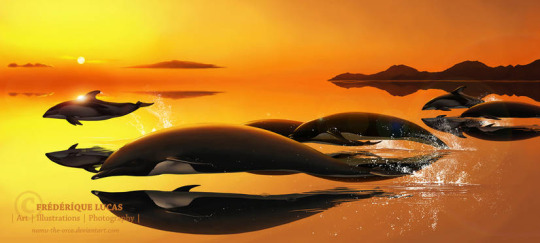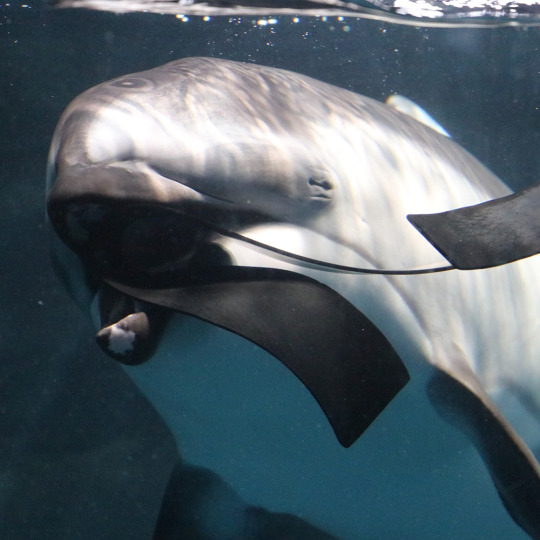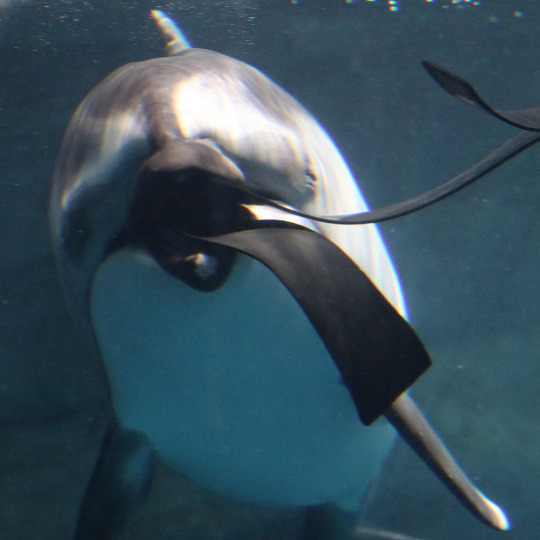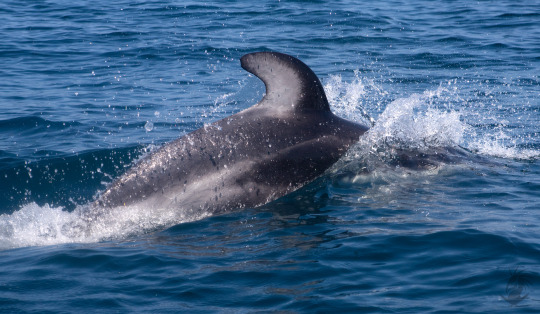#lagenorhynchus obliquidens
Explore tagged Tumblr posts
Text

A Pacific white sided dolphin (Lagenorhynchus obliquidens) in Cordell Bank National Marine Sanctuary, California
by NOAA/Jamie Hall
#pacific white sided dolphin#dolphins#cetaceans#marine mammals#lagenorhynchus obliquidens#lagenorhynchus#delphinidae#cetacea#artiodactyla#mammalia#chordata#wildlife: california#wildlife: usa#wildlife: north america
198 notes
·
View notes
Text

Look guys here's a really cool commission I recently got to work on. Someone asked me to create a speculative illustration of a hybrid between a False killer whale and Pacific white-sided dolphin. A very fun mental exercise with a little sleuthing involved!
The intended hybrid does not exist as far as we know, however both Lags and Pseudorcas have hybridised with - you guessed it - our favourite free-for-all baby maker the Common bottlenose dolphin. By looking at those hybrids I could see how the different colour patterns interacted, and try to sort of "filter out" the middle man. Lucky for me, Pseudorcas have a very similar colour scheme to bottlenoses, so I could make some inferences there too.
I'm quite pleased with the end result! Of course I can't say whether this is truly what a hybrid between these species would look like, but I do think it's a well informed guess. Makes for a pretty dolphin!
#illustrations#hybrid#hybridisation#speculative#speculative zoology#False killer whale#Pseudorca crassidens#Pacific white-sided dolphin#Lagenorhynchus obliquidens#dolphin#whale#cetacean#odontocete#digital art#scientific illustration
167 notes
·
View notes
Text

Pacific white-sided dolphin "Lagenorhynchus" obliquidens
Observed by anudibranchmom, CC BY-NC
#Lagenorhynchus obliquidens#Pacific white-sided dolphin#Cetacea#Delphinidae#cetacean#dolphin#North America#United States#California#Pacific Ocean#Monterey Bay
76 notes
·
View notes
Text



#poll#Class: Mammalia#Order: Artiodactyla#Family: Delphinidae#Genus: Lagenorhynchus#Lagenorhynchus Obliquidens
65 notes
·
View notes
Text
Lags are the specialist little guys in the world and it’s a shame not many people know this.
#pacific white-sided dolphin#for the uniformed#lag is short for their scientific name#lagenorhynchus obliquidens#bottlenose are what people picture when they think dolphin#but behavior wise I think lags are more what they have in mind#they are go go go jump jump jump all the time#dolphins#cetaceans#marine mammals
40 notes
·
View notes
Text
Dolphins and whales use sound to communicate, navigate and hunt. New research suggests that the collections of fatty tissue that enable toothed whales to do so may have evolved from their skull muscles and bone marrow. Scientists at Hokkaido University determined DNA sequences of genes which were expressed in acoustic fat bodies—collections of fat around the head that toothed whales use for echolocation. They measured gene expression in the harbor porpoise (Phocoena phocoena) and Pacific white-sided dolphin (Lagenorhynchus obliquidens). Their findings were published in the journal Gene.
Continue Reading.
189 notes
·
View notes
Text
Happy world whale day 🐋🐬🐳💙
#sorry minke whales. you lost to gray whales bc theyre on money in mexico :]#baleen whales#toothed whales#odontoceti#mysticeti#cetaceans#whales#🐋
43 notes
·
View notes
Text

Where the Water Meets the Sky - by Namu the Orca
Species depicted: Northern right whale dolphin (Lissodelphis borealis) and Pacific white-sided dolphin (Lagenorhynchus obliquidens) Time taken: ~10-15 hours References used: thetruthaboutlolita.webs.com/L… animal.memozee.com/ArchOLD-4/1… www.flickr.com/photos/jimscarf… www.flickr.com/photos/gtepke/3… Tools of the trade: Photoshop CS5
Well, here it is, finally! A mixed pod of both Northern right whale dolphins as well as Pacific white-sided dolphins breaking the glassy smooth surface during sunrise. I've wached the amazing movie 'Life of Pi' some time ago (it was really good, especially given the book was so detailed and difficult to put down in images) and was especially amazed by the scene where Pi wakes up in the morning and the ocean is simply one big mirror, perfectly reflecting the gorgeous sky above. Inspired, I decided to paint something like it - only then without the clouds as I kinda suck at those. The mini contest for the Northern right whale dolphin over at Exp-Marine-Mammals was drawing in near, and it struck me how (ant)arctic cetaceans especially are almost exclusively portrayed in grey or blue scenes. I wanted to flip that view all around and after some googling my suspicions were confirmed: sunrises over Japan, Alaska and the rest of the cold north can be just as orange and spectacular as anywhere else. Thus, this painting was born! It was a real challenge to say the least, mainly the splashes made me go crazy so in the end I just went with the fantastically helpful water splash brushes by FrostBo (I forgot which one it was, he's got several) and cut and modified them along the way where needed.

On a different note, it is quite interesting that both the Northern- as the well as the Southern right whale dolphin closely associate with a species of lagenorhynchus dolphins they share their range with. Whilst the Southerners come together with Dusky dolphins - and even interbreed! - the Northerners are very often seen with Pacific white-sided dolphins. Why would they do this? I know that there has been a proposed new taxonomy of the lagenorhynchus genus in which the Duskies and the Pacific white-sided dolphins would be placed together with Peale's in the genus of Sagmatias, but that is based on the idea these dolphins are more closely related to the cephalorhynchus dolphins. Does anyone know the reason for this Lagenorhynchus/Lissodelphis 'friendship'?
0 notes
Text
Comparative transcriptomics shows the evolutionary origin of acoustic fat bodies through a trade-off with skull muscles in toothed whales
Toothed whales (odontocetes) have developed acoustic fat bodies, which include forehead melon, extra-mandibular fat body and intra-mandibular fat body. These contribute to the sound transmission pathways in the unique echolocation process of toothed whales. The acoustic fat bodies of Odontocetes accumulate unusual fatty acids, making them novel traits with unique functional anatomy and chemistry. This study provides new insights into the evolutionary origin and lipid utilisation of acoustic fat bodies in harbour porpoise (Phocoena phocoena) and Pacific white-sided dolphin (Lagenorhynchus obliquidens) using comparative transcriptomics. Comprehensive gene expression analyses indicated that the acoustic fat bodies of toothed whales are composites of muscle and adipose tissues, mainly composed of intramuscular fat. The extra-mandibular fat body is a homologue of the masseter muscle. Additionally, we demonstrated that gene expression-based functional enrichments for specialised branched-chain amino acid metabolism, endocytosis, lysosomes and peroxisomes contribute to the maintenance of the unique fatty characteristics of the acoustic fat bodies of toothed whales. A trade-off occurred in the evolution of acoustic fat bodies as a result of the fatty reorganisation of head muscles involved in aquatic adaptation in toothed whales. http://dlvr.it/Spd0ld
1 note
·
View note
Photo


なんかゴムをおいしそうにしゃぶり続けていた
昆布みたいでおいしかったのかもしれん…
@海遊館
5 notes
·
View notes
Text

Pacific White Sided Dolphin (Lagenorhynchus obliquidens)
taken in the Pacific Ocean somewhere off the coast of California
status: least concern
They are sometimes called the hooked fin porpoise, its easy to see why on this particular individual with a significant hook to its dorsal fin! There were several in this speedy group with fins hooked to this degree but this was the only one that wanted (sort of) to star in a photo.
#Pacific White Sided Dolphin#Dolphin#toothed whale#Lagenorhynchus obliquidens#cetacean#ocean#wild earth#wild ocean#wildlife#pacific ocean#photo#photography#canon#canon 6d mark ii
3 notes
·
View notes
Photo

• HYBRID DOLPHINS • - Species: Northern right whale dolphin (Lissodelphis borealis) x Pacific white-sided dolphin (Lagenorhynchus obliquidens) - Parentage: unknown, possibly dam x sire - Status in the wild: probable | Status in captivity: X View the entire hybrid dolphin series
Every once in a while southern right whale dolphins grace whale-watchers with their presence. And, swimming alongside them, is usually another species: the dusky dolphin. Duskies often go alone, but rarely do the right whale dolphins appear without their finned friends. Curiously, both species find their mirrors on the opposite hemisphere. Here swim the northern right whale dolphin (Lisso) and Pacific white-sided dolphin (Lag), which not only look similar but are just as close-knit. All that socialising down south gave us our previous hybrid. And it seems the same has happened up north.
Although never ‘publicly’ observed (let alone scientifically described) there have been sightings of apparent hybrids in the Pacific. They were described as essentially a Lisso, except for that tell-tale mini dorsal fin in black and grey. Sadly I have not seen photos myself, but I spoke to people who have. They are secondhand accounts though and differ slightly: one said the hybrid had noticeably bigger pectoral fins and snout like a Lag, while the other said it looked like a Lisso spare the dorsal fin. These descriptions were invaluable, yet granted few solid details. As such the entire illustration should be labeled an ‘educated guess’. The true appearance of this hybrid is unknown.
However, known right whale dolphin hybrids offered some clues. The dorsal fin was a give-away: the colouring borrowed from Lags, with the reduced shape and size seen in the other hybrids. Due to this one being described as “looking like a Lisso, except-” I chose a very slim body shape, less influenced by the Lag. Interesting to note is that southern Lissos are a lot sturdier than their northern counterparts, especially in the face, and it shows in the hybrids too! Most of all I debated the colour of the throat. How much influence would the Lag’s white have on the Lisso’s steady black? Neither of my sources mentioned it - but it would be easy to miss in a fleeting encounter. In the end a fellow hybrid made me opt for an entirely off-white throat, with an extra white patch for the Lisso’s chin patch. Add some light facial markings and we get something that clearly has Lag influenced beak and pectoral fins, but which could also easily be mistaken for a normal Lisso when seen in a pod - spare that dorsal fin. It’s funny, creating illustrations like this. All the choices made are logically sound, and yet there is still a good chance the actual hybrid does not look like this at all. Maybe one day another one will be seen and we can all marvel at the photographs. Until then, this is my best guess.
• REFERENCES • - A. Janiger and T. Pusser, personal communication
#illustrations#scientific illustration#hybrid#hybrid dolphins#northern right whale dolphin#lissodelphis borealis#Pacific White-sided Dolphin#Lagenorhynchus obliquidens#lagenorhynchus#Lissodelphis#lag#lisso#dolphin#digital art#hybrid dolphin
88 notes
·
View notes
Text

Pacific white-sided dolphin "Lagenorhynchus" obliquidens
Observed by katlynrt, CC BY-NC
#Lagenorhynchus obliquidens#Pacific white-sided dolphin#Cetacea#Delphinidae#cetacean#dolphin#North America#United States#California#Pacific Ocean
54 notes
·
View notes
Video
Pacific White-sided Dolphins par Tory Kallman Via Flickr : Pacific white-sided dolphin (Lagenorhynchus obliquidens) Taken aboard Monterey Bay Whale Watch on the all day trip 05/03/2019.
#Pacific white-sided dolphin#l ags#Lagenorhynchus obliquidens#white sided#pwsd#nature#wild#underwater#free#super pod#pod#dolphin#wildlife#ocean#pacific ocean#monterey#monterey bay#monterey bay whale watching#whale watching#dolphins
6 notes
·
View notes

